Hongbo Jiang
KORE: Enhancing Knowledge Injection for Large Multimodal Models via Knowledge-Oriented Augmentations and Constraints
Oct 22, 2025Abstract:Large Multimodal Models encode extensive factual knowledge in their pre-trained weights. However, its knowledge remains static and limited, unable to keep pace with real-world developments, which hinders continuous knowledge acquisition. Effective knowledge injection thus becomes critical, involving two goals: knowledge adaptation (injecting new knowledge) and knowledge retention (preserving old knowledge). Existing methods often struggle to learn new knowledge and suffer from catastrophic forgetting. To address this, we propose KORE, a synergistic method of KnOwledge-oRientEd augmentations and constraints for injecting new knowledge into large multimodal models while preserving old knowledge. Unlike general text or image data augmentation, KORE automatically converts individual knowledge items into structured and comprehensive knowledge to ensure that the model accurately learns new knowledge, enabling accurate adaptation. Meanwhile, KORE stores previous knowledge in the covariance matrix of LMM's linear layer activations and initializes the adapter by projecting the original weights into the matrix's null space, defining a fine-tuning direction that minimizes interference with previous knowledge, enabling powerful retention. Extensive experiments on various LMMs, including LLaVA-v1.5-7B, LLaVA-v1.5-13B, and Qwen2.5-VL-7B, show that KORE achieves superior new knowledge injection performance and effectively mitigates catastrophic forgetting.
Pedestrian Trajectory Prediction Based on Social Interactions Learning With Random Weights
Jan 13, 2025



Abstract:Pedestrian trajectory prediction is a critical technology in the evolution of self-driving cars toward complete artificial intelligence. Over recent years, focusing on the trajectories of pedestrians to model their social interactions has surged with great interest in more accurate trajectory predictions. However, existing methods for modeling pedestrian social interactions rely on pre-defined rules, struggling to capture non-explicit social interactions. In this work, we propose a novel framework named DTGAN, which extends the application of Generative Adversarial Networks (GANs) to graph sequence data, with the primary objective of automatically capturing implicit social interactions and achieving precise predictions of pedestrian trajectory. DTGAN innovatively incorporates random weights within each graph to eliminate the need for pre-defined interaction rules. We further enhance the performance of DTGAN by exploring diverse task loss functions during adversarial training, which yields improvements of 16.7\% and 39.3\% on metrics ADE and FDE, respectively. The effectiveness and accuracy of our framework are verified on two public datasets. The experimental results show that our proposed DTGAN achieves superior performance and is well able to understand pedestrians' intentions.
RobWE: Robust Watermark Embedding for Personalized Federated Learning Model Ownership Protection
Feb 29, 2024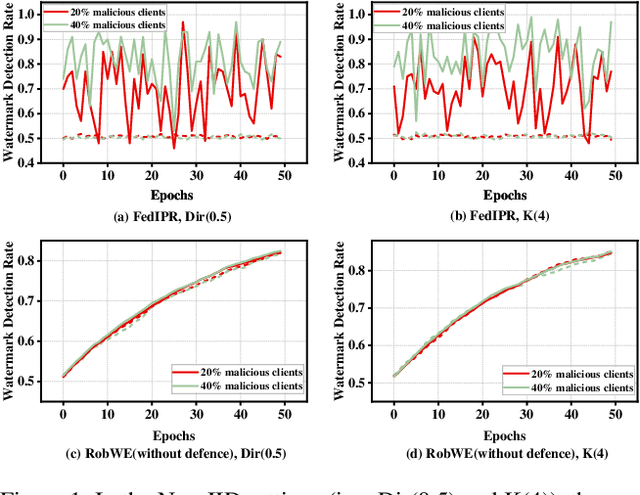



Abstract:Embedding watermarks into models has been widely used to protect model ownership in federated learning (FL). However, existing methods are inadequate for protecting the ownership of personalized models acquired by clients in personalized FL (PFL). This is due to the aggregation of the global model in PFL, resulting in conflicts over clients' private watermarks. Moreover, malicious clients may tamper with embedded watermarks to facilitate model leakage and evade accountability. This paper presents a robust watermark embedding scheme, named RobWE, to protect the ownership of personalized models in PFL. We first decouple the watermark embedding of personalized models into two parts: head layer embedding and representation layer embedding. The head layer belongs to clients' private part without participating in model aggregation, while the representation layer is the shared part for aggregation. For representation layer embedding, we employ a watermark slice embedding operation, which avoids watermark embedding conflicts. Furthermore, we design a malicious watermark detection scheme enabling the server to verify the correctness of watermarks before aggregating local models. We conduct an exhaustive experimental evaluation of RobWE. The results demonstrate that RobWE significantly outperforms the state-of-the-art watermark embedding schemes in FL in terms of fidelity, reliability, and robustness.
Spatial-Temporal Conv-sequence Learning with Accident Encoding for Traffic Flow Prediction
May 21, 2021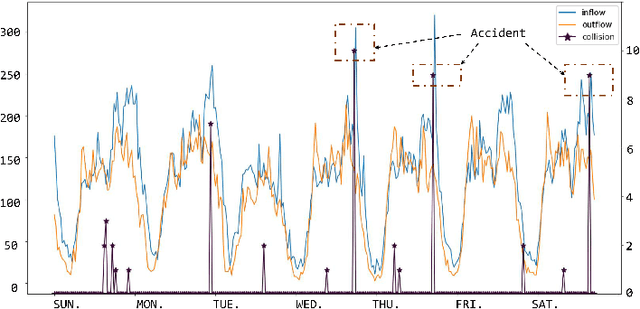
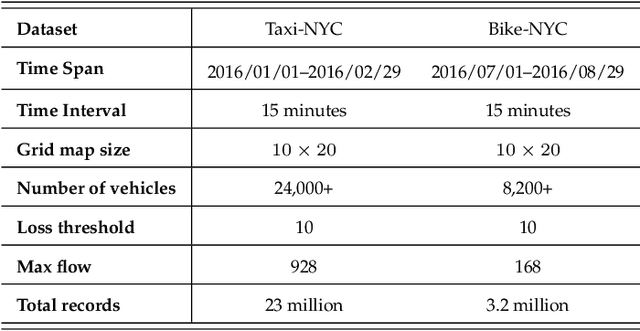
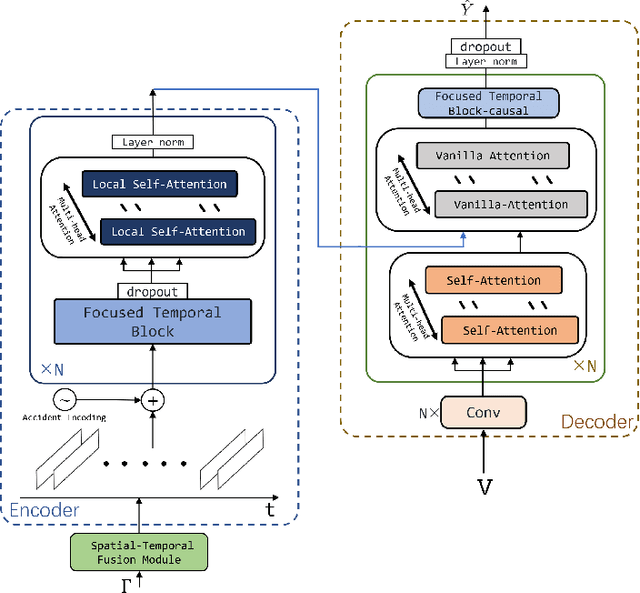
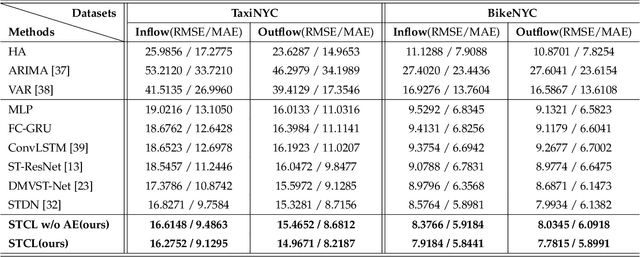
Abstract:In intelligent transportation system, the key problem of traffic forecasting is how to extract the periodic temporal dependencies and complex spatial correlation. Current state-of-the-art methods for traffic flow prediction are based on graph architectures and sequence learning models, but they do not fully exploit spatial-temporal dynamic information in traffic system. Specifically, the temporal dependence of short-range is diluted by recurrent neural networks, and existing sequence model ignores local spatial information because the convolution operation uses global average pooling. Besides, there will be some traffic accidents during the transitions of objects causing congestion in the real world that trigger increased prediction deviation. To overcome these challenges, we propose the Spatial-Temporal Conv-sequence Learning (STCL), in which a focused temporal block uses unidirectional convolution to effectively capture short-term periodic temporal dependence, and a spatial-temporal fusion module is able to extract the dependencies of both interactions and decrease the feature dimensions. Moreover, the accidents features impact on local traffic congestion and position encoding is employed to detect anomalies in complex traffic situations. We conduct extensive experiments on large-scale real-world tasks and verify the effectiveness of our proposed method.
PURE: Passive mUlti-peRson idEntification via Deep Footstep Separation and Recognition
Apr 15, 2021

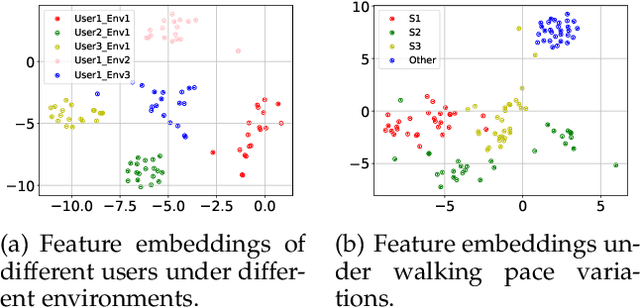
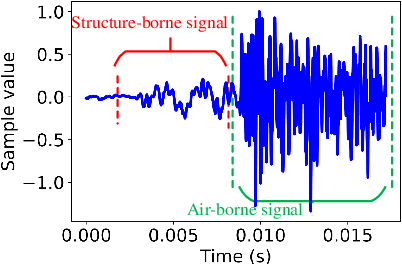
Abstract:Recently, \textit{passive behavioral biometrics} (e.g., gesture or footstep) have become promising complements to conventional user identification methods (e.g., face or fingerprint) under special situations, yet existing sensing technologies require lengthy measurement traces and cannot identify multiple users at the same time. To this end, we propose \systemname\ as a passive multi-person identification system leveraging deep learning enabled footstep separation and recognition. \systemname\ passively identifies a user by deciphering the unique "footprints" in its footstep. Different from existing gait-enabled recognition systems incurring a long sensing delay to acquire many footsteps, \systemname\ can recognize a person by as few as only one step, substantially cutting the identification latency. To make \systemname\ adaptive to walking pace variations, environmental dynamics, and even unseen targets, we apply an adversarial learning technique to improve its domain generalisability and identification accuracy. Finally, \systemname\ can defend itself against replay attack, enabled by the richness of footstep and spatial awareness. We implement a \systemname\ prototype using commodity hardware and evaluate it in typical indoor settings. Evaluation results demonstrate a cross-domain identification accuracy of over 90\%.
 Add to Chrome
Add to Chrome Add to Firefox
Add to Firefox Add to Edge
Add to Edge